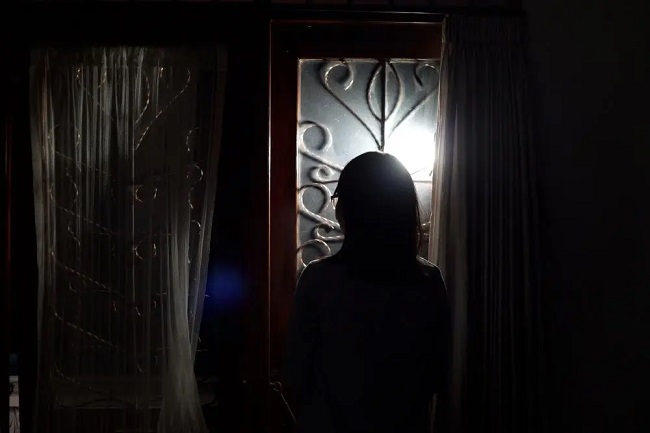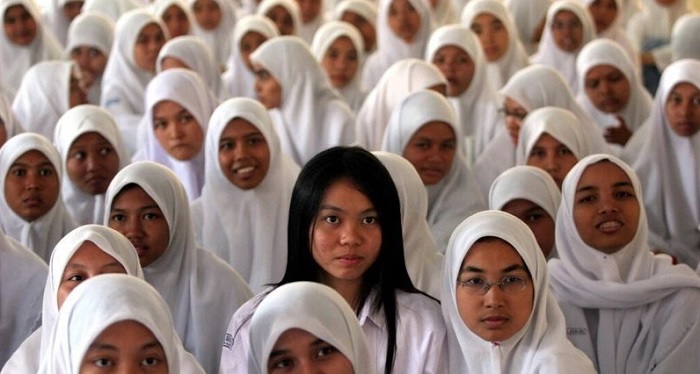Nanak Hikmatullah
The saga of the school dress code continues. Several petitions have emerged on online platforms, such as change.org, including one petition that has gathered over 16,000 signatures (and growing). It calls for the government to address the practice of insisting that pupils and teachers in Indonesia’s public schools obey and enforce local sharia regulations on Islamic dress.
A recent Twitter trending topic even called for the return to the school uniforms seen in the 1990s and 2000s with the tagline Sekolah Negeri, BUKAN Sekolah Islam (Public School, NOT Islamic School). The image shows what school uniforms worn by both male and female students were like at the time, as depicted in the famous coming-of-age movie Ada Apa Dengan Cinta?. The picture highlights the hallmark of the old style of school dress code: shorts for elementary and middle school male students, trousers for high school male students and skirts for elementary to high school female students. Hijab (Muslim apparel covering the head, neck, and chest) is an alternative uniform (as opposed to mandatory) for Muslim female students who choose to wear it.
The ‘old-style’ school uniform dates back to Japanese colonisation. At that time, no specific colour was required and it was not until the Soeharto era that the school uniform became legally regulated, by a decree issued by the Directorate General of Primary and Secondary Education on 17 March 1982. The goal was to reduce social divisions between students and to maintain a moderate dress code. The decree governed the school uniform colours we know today (white and red for elementary school, white and blue for middle school, and white and grey for high school). Chapter 8, article 11, of the decree specified the characteristics of the uniform for male and female students. For example, elementary school female students had to wear a skirt 5cm above the knee, whereas middle and high school female students wore a skirt 5cm below the knee. While hijab was mentioned as an alternative, long-sleeved shirts and long skirts – which seem to be the current norm – were not.
Maintenance and resistance
The current debate on school uniforms is not new. It represents the latest episode in a long struggle between at least two groups: those who support the religious dress code based on a rationale to better the younger generation, and those who oppose the rule as a violation of basic human rights. This recent case can be traced to the hijab enforcement issue at a high school in Padang, West Sumatera in 2021. A non-Muslim female student reported being forced to wear a hijab at school. The story went viral and caught the attention of the Minister of Education, Nadiem Makarim. The Padang case seems to be only the tip of the iceberg of what appears to be prolonged mistreatment of non-Muslim students forced to conform to the majority’s orders. Such a case is not unique to non-Muslims; Muslim students living in non-Muslim majority parts of the country, such as predominantly Hindu Bali, have reported similar unfair treatment, including being restricted from wearing a school uniform with any religious attributes.
Gasss lah @Kemdikbud_RI
— Mazdjo PRAY (@MazdjoPray) July 30, 2022
Berani? pic.twitter.com/Twyvf8dvyy
In February 2021 a joint ministerial decree was signed by the Ministry of Education and Culture, the Ministry of Home Affairs, and the Ministry of Religion in an effort to avoid escalation of the issue. It called for provincial governments to revoke this seemingly discriminatory rule in elementary and secondary schools. In the spirit of Indonesia’s national motto Bhineka Tunggal Ika (Unity in Diversity) and promoting tolerance, the Minister of Education Nadiem Makarim stated that schoolgirls and female teachers should be allowed to wear or not to wear religious attributes, and that schools should respect their decisions. Failure to comply would result in several sanctions, such as funding cuts.
As expected, this decision is a zero-sum game, a triumph for one party but a loss for the other. In its wake, a large social organisation in West Sumatera submitted a request for judicial review to the Supreme Court. In May 2021, around two months after it was issued, a Supreme Court decision overruled the decree, judging that it violated four national laws: Regional Govt Law (UU No. 23/2014), National Education System Law (UU No. 20/2003), Child Protection Law (UU No. 35/2014), and Establishment of Legislation Law (UU No. 12/2011). They stated that girls under 18 years have no right to choose their own clothes, nor that hijab in public schools can be enforced nor banned. Consequently, school dress code controls thrived once again.
Maintaining moral standards?
For the protesters of the dress code, the imposition of religious attributes in public schools is an example of discrimination often overlooked in societies with strong religiosity, such as Indonesia. The proponents of the dress code defend their arguments by saying that the goal of national education is to create a faithful, devoted, and noble generation, in line with the 1945 constitution. Enforcing religious dress code is one way of enacting this vision. While the end goal seems comforting, a closer look into the case shows that enforcing religious school uniforms is not simply about morality; it is also about the maintenance of the current social order. It portrays the chronic practice of a deficit view toward school children and women.
Public schools in Indonesia have long upheld a hierarchical structure and top-down management. This practice is evident in school cultures that treat students as passive individuals. To borrow a concept from Brazilian critical educator and activist Paolo Freire, schools in Indonesia are like a bank in which students are empty vessels for depositing whatever the adults think is right for them. The strict enforcement of the religious clothing code manifests this mentality by assuming students do not know any better about what to wear. While Indonesia’s Child Protection Law upholds the principle that children can speak up, their voices are not guaranteed to be heard. This practice also reveals how supporters of the dress code perceive women. As the protesters argued, forcing adult female teachers to wear certain garments (or not wear others) violates the basic human rights of personal privacy and freedom from discrimination.

The reasoning behind enforcing religious attributes for the sake of morality is also a dubious one. There is more to morality than just school uniforms. For the opponents of the religious dress code, discriminating against students for not complying with a certain religious dress code is in itself an immoral act. As such, wearing or not wearing religious attributes does not, and should not, define a person’s moral standards. What concerns them the most are the discriminatory practices that come because of this enforcement.
Human Rights Watch Indonesia’s 2022 report shows that at least 24 of Indonesia’s 34 provinces have regulated religious dress codes in public schools. Many people worry that this will lead to other cases similar to the one in Padang. There have already been reports of bullying, discrimination, and small-scale offences directed against Muslims and non-Muslims who disobey the rule. Some students even reported that not wearing a hijab affects their grades, and for teachers, it can jeopardise their teaching careers. This practice also puts school children and female teachers in boxes and labels them moral and immoral based on their clothing choices. Instead of providing comfort and protection for the wearer, school uniforms have become a disciplinary protocol.
The vacant law
The debate over religious attributes results from the vacant law of hijab apparel in public schools and the contradicting regulations between central and regional governments. Although the central government funds the schools, regional governments hold the authority over public schools in their districts. Moreover, many regions in Indonesia have strong religious ties and local customs. The tension between central and regional governments and local customs affects how schools operate. Schools have their own regulations for what they think is best for their students and staff. For example, a recent tweet showed that a school in Bantul, Yogyakarta, has their own school uniform standards.
School dress codes are perhaps another example of other discriminatory practices in schools going unchecked. Who are the victims in this hegemony of adults? Those whose voices are usually unheard, such as children and women. Until this chronic condition, the hegemony of the adults, is healed, public schools in Indonesia will seem to remain oppressive and another episode of this school uniform saga might unfold.
Nanak Hikmatullah (nhikmatullah@umass.edu) is a PhD student at the University of Massachusetts, Amherst, a Fulbright scholar, and a lecturer at the Edgar Brood Academic Chair, Indonesia. He is currently working on #HumanisingEducation, an education approach promoting a more humane pedagogy in Indonesia.
